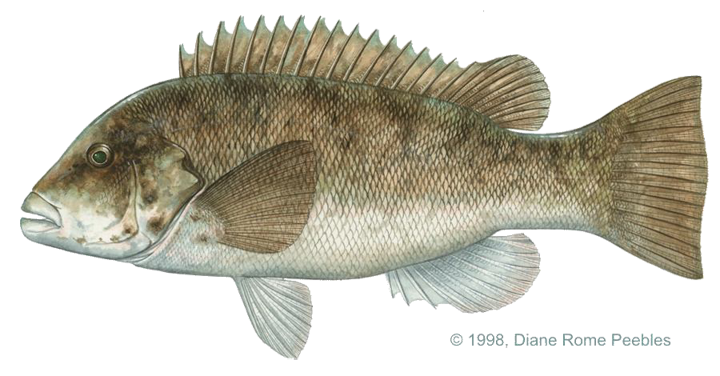Game Fish Identification Reference Guides
Tautog
(Tautoga onitis)
(Tautoga onitis)

(Linnaeus, 1758); LABRIDAE FAMILY; also called blackfish, tog, Molly George, chub, oysterfish
Occurs in the western Atlantic Ocean from Nova Scotia, Canada to South Carolina, U.S.A., with the greatest abundance between Cape Cod, Massachusetts and Delaware Bay. It is known to move in and out of bays or in shore and off shore according to the water temperature, but it does not make extensive migrations up and down the coast. It prefers shallow waters over rocky bottoms, shell beds, inshore wrecks, etc., which it often inhabits year round.
It is a member of the wrasse family which, with 450 species in 60 known genera, is one of the largest families of fishes. It includes, the cunner (Tautogolabrus adspersus), the hogfish (Lachnolaimus maximus) and the California redfish (Pimelometo pon pulcher).
The first dorsal fin has 16 17 spines of almost equal length. The short second dorsal fin consists of 10 somewhat longer soft rays. The anal fin has 3 spines and 7 8 soft rays. There is a detached area of small scales behind and beneath the eye, but none of the opercle. The lateral line is arched more or less following the contour of the back and has a scale count of 69 73. There are 9 gill rakers on the first branchial arch, 3 on the upper limb and 6 on the lower limb. A number of small teeth are present along the sides of the jaws and there are 2 3 large canine teeth in the tips. Young are generally brown or greenish brown with irregular dark mottling or blotching on the flanks. Larger specimens may be entirely black or charcoal gray, sometimes with greenish overtones, or they may be mottled with brown, black or white. The belly and chin are white or gray and there may be spots on the chin. Females develop a white saddle down the middle of each side during spawning.
Its diet is mainly of mollusks and crustaceans, the blue mussel being the most abundant food item. Fishing methods include bait fishing over rocky bottoms, shell beds, or in shore wrecks from an anchored boat, as well as bottom fishing from the shore in the late spring and fall months. Baits include crabs, clams, worms, mussels, shrimp and sand bugs. It is not a fast or extremely active species, but it puts up a very stubborn fight. Its year round availability, together with its large size and stubborn disposition, make it a popular sport fish. The flesh is edible and of good quality
Occurs in the western Atlantic Ocean from Nova Scotia, Canada to South Carolina, U.S.A., with the greatest abundance between Cape Cod, Massachusetts and Delaware Bay. It is known to move in and out of bays or in shore and off shore according to the water temperature, but it does not make extensive migrations up and down the coast. It prefers shallow waters over rocky bottoms, shell beds, inshore wrecks, etc., which it often inhabits year round.
It is a member of the wrasse family which, with 450 species in 60 known genera, is one of the largest families of fishes. It includes, the cunner (Tautogolabrus adspersus), the hogfish (Lachnolaimus maximus) and the California redfish (Pimelometo pon pulcher).
The first dorsal fin has 16 17 spines of almost equal length. The short second dorsal fin consists of 10 somewhat longer soft rays. The anal fin has 3 spines and 7 8 soft rays. There is a detached area of small scales behind and beneath the eye, but none of the opercle. The lateral line is arched more or less following the contour of the back and has a scale count of 69 73. There are 9 gill rakers on the first branchial arch, 3 on the upper limb and 6 on the lower limb. A number of small teeth are present along the sides of the jaws and there are 2 3 large canine teeth in the tips. Young are generally brown or greenish brown with irregular dark mottling or blotching on the flanks. Larger specimens may be entirely black or charcoal gray, sometimes with greenish overtones, or they may be mottled with brown, black or white. The belly and chin are white or gray and there may be spots on the chin. Females develop a white saddle down the middle of each side during spawning.
Its diet is mainly of mollusks and crustaceans, the blue mussel being the most abundant food item. Fishing methods include bait fishing over rocky bottoms, shell beds, or in shore wrecks from an anchored boat, as well as bottom fishing from the shore in the late spring and fall months. Baits include crabs, clams, worms, mussels, shrimp and sand bugs. It is not a fast or extremely active species, but it puts up a very stubborn fight. Its year round availability, together with its large size and stubborn disposition, make it a popular sport fish. The flesh is edible and of good quality












